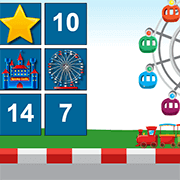
This article will discuss prime factorization and its relationship to factor trees. We'll also be discussing common prime factorization problems and the issues they can cause to factor trees. We'll also be explaining the DIE icon and how to use. Finally, we'll discuss how to generate your own examples.
Prime factorization
Factor trees provide a way to find prime numbers for a number. These trees show successive factor pairs as branches. At the end of each tree, the number is written as a product of the prime elements. Factor trees don't use the number 1, unlike factor lists.

Prime factorization calculator
Prime factorization calculators make it easy to determine the prime numbers of a number. These calculators will allow you to input a composite number, and produce a list prime numbers that divide it. These prime numbers will each be highlighted with a different color. The prime factors will be highlighted with a different color according to their exponents.
Common prime factor in factor trees
Factor trees can be used to find the greatest common factor between two numbers. This technique is also called prime factorization. It involves identifying all the common factors and finding the prime numbers. The common factors are then multiplied by the other number to find the GCF.
Problems with factor trees
Factor trees are a form of math problem in which a number and its factor are placed into a tree with branches or leaves. These numbers are called "prime factors". A prime factor is generally three times larger than a whole number. The product of two prime elements is called a whole number.
Use factor trees to determine GCF
A factor tree can be used to calculate the GCF for any number. A factor tree is a collection of numbers with the same prime factor. To calculate the GCF, prime factors from two or more numbers need to be divided equally. To do this, we can create a list containing prime factors.

LCM - Finding it
The first step to finding LCM factor trees is to determine the prime factorization of any given number. Prime factors are numbers which divide evenly into one or more numbers. Once you have calculated the prime factorization for a number, you can calculate the LCM.
FAQ
How long does a teacher of early childhood take?
It takes four years to complete a bachelor's degree in early childhood education. Two years are required to take general education courses offered by most universities.
After you have completed your undergraduate education, you can usually apply to graduate school. This step allows for you to specialize in one area of study.
One example is to choose to specialize in child psychology or learning difficulties. After completing your master's you will need to apply to a teacher training program.
This process will take another few years. This period will be filled with learning opportunities and collaborations with educators.
Finally, to be able to officially start working as a teacher, you will need pass the state exams.
It takes many years for this process to complete, so you may not be able immediately to join the workforce.
Homeschooling is for everyone.
Anyone can homeschool. There aren't any requirements.
It is possible for parents to teach their children after they have finished high school. Many families decide to teach their grandchildren while they are still in high school.
Parents who have less formal education may be able to teach their children.
After completing certain requirements, parents can become teachers certified. These requirements differ from one state.
Some states require homeschooled students take a test to graduate. Others do not.
Homeschooling parents must register their family with the local school district.
This involves filling out paperwork that is then submitted to the school board.
After registering, parents are allowed to enroll their children in public or private schools.
A few states allow parents to homeschool without registering their children with the government.
If you live in one of these states, you will be responsible for ensuring your children meet the requirements of the state's compulsory attendance law.
How much does homeschooling cost?
Homeschooling is free. There are no set fees. Some families charge between $0-$20 per lesson. Other families offer no-cost services.
Homeschooling takes dedication and commitment. Parents need to make sure they have enough time to spend with their children.
They also need to have access book, supplies, books, and other learning resources. Homeschoolers often need to take advantage of community events and programs to supplement their curriculum.
Parents must think about the cost of transport, tutoring, and other extracurricular activities.
Homeschoolers should also plan ahead for vacations, field trips, and special occasions.
What is an alternate school?
An alternative school is a school that offers students with learning difficulties education with the help of qualified teachers who are sensitive to their individual needs.
Alternative schools provide special education opportunities for children with special needs.
Additional support is available if needed.
Alternative schools do not exist for students who are exclusion from mainstream schools.
They are open for all children, regardless their ability or disability.
What is early education for children?
Early Childhood Education is a profession that aims to help children become happy, healthy adults. It involves everything from teaching children to read to preparing for kindergarten.
Early childhood education aims to help children learn and grow through age-appropriate experiences.
Early childhood educators often have to assess each child's developmental needs. This helps to determine if a program is right for each child.
Parents also have the opportunity to meet teachers and other professionals who are familiar with working with young children in early childhood programs.
A key role in early childhood education is also played by parents. They should be able and willing to help their children in any way they can.
Parents can participate in activities that will teach their children life skills.
While preschool education is sometimes called early child education, the term is also used interchangeably to describe daycare centers. Prekindergarten education begins at three years of age, but early childhood education can begin around three.
Statistics
- In most developed countries, a high proportion of the population (up to 50%) now enters higher education at some time in their lives. (en.wikipedia.org)
- Globally, in 2008, around 89% of children aged six to twelve were enrolled in primary education, and this proportion was rising. (en.wikipedia.org)
- Think of the rhetorical power of nineteenth-century abolitionist Harriet Beecher Stowe, Martin Luther King, Jr., or Occupy Wall Street activists with their rallying cry of “we are the 99 percent.” (bostonreview.net)
- These institutions can vary according to different contexts.[83] (en.wikipedia.org)
- They are more likely to graduate high school (25%) and finish college (116%). (habitatbroward.org)
External Links
How To
Why homeschool?
There are many factors that you need to consider when deciding whether or not to homeschool.
-
Which type of education do YOU want for your child's future? Are you looking for academic excellence or social skills development?
-
What degree of involvement would you prefer to have in your child’s education. Are you more interested in being kept informed about your child's progress? Do you prefer to stay informed about what your child is doing?
-
Does your child have special needs? How can you help your child?
-
Will you be able to manage your child's schedule? Are you able to commit to teaching your child at-home every day?
-
What subjects will your course cover? Math, science, language arts, art, music, history, geography, etc. ?
-
How much money do your parents have available for education?
-
Is it possible for your child to start school at an early age?
-
What is the best place to house your child? This includes finding space large enough to house your child, as well providing facilities such as bathrooms and kitchens.
-
What is the age of your child?
-
When is your child supposed to go to bed?
-
When does he/she wake-up?
-
How long does it take for you to get from A to B?
-
What distance is your child from school?
-
How far is it from your home to your child's school.
-
How will you transport your child to and from school?
-
What are some of the benefits of homeschooling
-
What are the downsides?
-
Who will look after your child outside?
-
What are you expecting from your child's education?
-
Which discipline will you choose?
-
What curriculum will your school use?
There are many reasons that people homeschool their children. Here are some of the reasons.
-
Your child has learning difficulties that prevent him/her to attend traditional schools.
-
You would like to offer your child an alternative educational system.
-
You require more flexibility in your scheduling.
-
You don't want to pay high tuition fees.
-
You feel your child is getting a better education than you could in a traditional school.
-
You believe you know more about your child than the teacher in traditional school settings.
-
You don’t like the way that schools work.
-
You are not comfortable with the school's regulations.
-
You want your child's work ethic to be strong.
-
You want to give your child the freedom to choose what courses you take.
-
You want individualized attention for your child.
Homeschooling also offers many other benefits, such as:
-
There is no need to worry about uniforms, books, pencils, paper, or supplies.
-
Your child can be educated according to their interests.
-
Parents can spend more time with their children when they homeschool.
-
Homeschooled students are more likely to learn faster than their peers, as they aren't distracted by other people.
-
Homeschoolers score higher on standardized exams.
-
Homeschool families tend to be happier overall.
-
Homeschool students are less likely not to drop out.